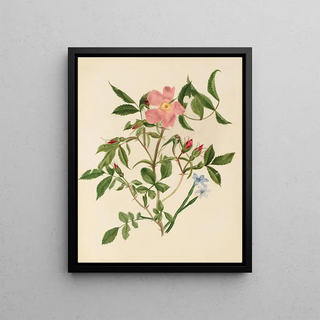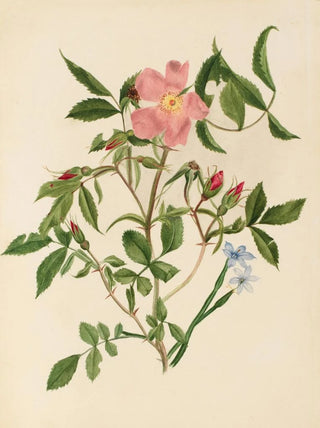Art print | Wild Rose and Blue-eyed Grass - Mary Vaux Walcott


View from behind

Frame (optional)
Captivating Introduction
In the enchanting world of botanical art, the piece "Wild Rose and Blue-eyed Grass" by Mary Vaux Walcott stands out for its delicacy and keen sense of observation. This artwork, which evokes the fleeting beauty of nature, invites viewers to a profound contemplation. By highlighting often overlooked elements, Walcott manages to capture the very essence of American flora, offering a window into a world of colors and textures. The art print of this piece becomes a true homage to the richness of biodiversity, while celebrating the talent of an artist who masterfully combines science and aesthetics.
Style and uniqueness of the work
Mary Vaux Walcott's style is characterized by remarkable meticulousness and a naturalist approach. Every petal, every leaf is depicted with precision that reflects attentive observation and a deep love for nature. In "Wild Rose and Blue-eyed Grass," vibrant hues and refined details create a visual harmony that attracts and captivates. The artist uses a palette of soft colors, evoking the natural light that bathes the plant world. Shades of green and pink blend gracefully, while the delicate shapes of flowers and leaves seem almost tangible. This piece does not merely depict nature; it elevates it to the level of art, transforming ordinary elements into an extraordinary visual experience.
The artist and her influence
Mary Vaux Walcott, botanist and artist, played a crucial role in documenting North American plants. Her commitment to preserving flora and her passion for art converge in her works, which are both scientific and poetic. As a member of the American Botanical Society, Walcott contributed to raising public awareness about the importance of conserving plant species. Her legacy endures through her illustrations, which continue to inspire art and nature enthusiasts. Rediscovering her work reveals how timeless her creations are and how they still resonate today, in a world where nature is often sidelined.

Matte finish

View from behind

Frame (optional)
Captivating Introduction
In the enchanting world of botanical art, the piece "Wild Rose and Blue-eyed Grass" by Mary Vaux Walcott stands out for its delicacy and keen sense of observation. This artwork, which evokes the fleeting beauty of nature, invites viewers to a profound contemplation. By highlighting often overlooked elements, Walcott manages to capture the very essence of American flora, offering a window into a world of colors and textures. The art print of this piece becomes a true homage to the richness of biodiversity, while celebrating the talent of an artist who masterfully combines science and aesthetics.
Style and uniqueness of the work
Mary Vaux Walcott's style is characterized by remarkable meticulousness and a naturalist approach. Every petal, every leaf is depicted with precision that reflects attentive observation and a deep love for nature. In "Wild Rose and Blue-eyed Grass," vibrant hues and refined details create a visual harmony that attracts and captivates. The artist uses a palette of soft colors, evoking the natural light that bathes the plant world. Shades of green and pink blend gracefully, while the delicate shapes of flowers and leaves seem almost tangible. This piece does not merely depict nature; it elevates it to the level of art, transforming ordinary elements into an extraordinary visual experience.
The artist and her influence
Mary Vaux Walcott, botanist and artist, played a crucial role in documenting North American plants. Her commitment to preserving flora and her passion for art converge in her works, which are both scientific and poetic. As a member of the American Botanical Society, Walcott contributed to raising public awareness about the importance of conserving plant species. Her legacy endures through her illustrations, which continue to inspire art and nature enthusiasts. Rediscovering her work reveals how timeless her creations are and how they still resonate today, in a world where nature is often sidelined.






